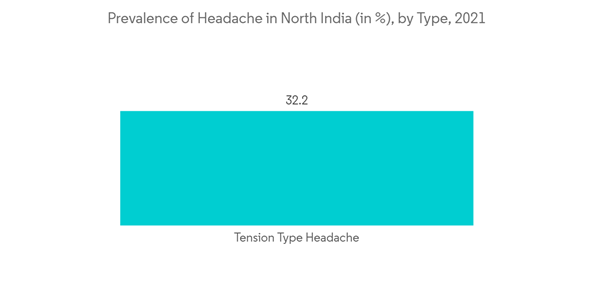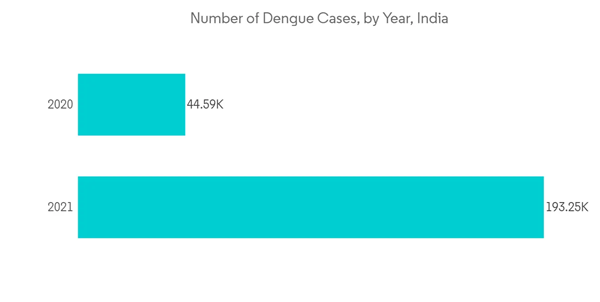The COVID-19 pandemic had a significant impact on the market. For instance, India's manufacturers rely heavily on imports of their active pharmaceutical ingredients (APIs) from China. The lockdown slowed the production of APIs, resulting in less availability and higher costs for the materials required for the products. Owing to the high demand for essential OTC drugs, the government restricted the export of some essential medicine. Besides over-the-counter painkillers and fever reducer paracetamol, drugs restricted for exports include common antibiotics, metronidazole, and those used to treat bacterial and other infections, as well as vitamin B1 and B12 ingredients. Due to the countrywide lockdown, the traditional supply chain of OTC drugs faced a lot of difficulties. Many of the essential OTC drugs were not available. Even after the specific guidelines and support of the state government to transport essential OTC drugs, many retail pharmacies faced a shortage of stock. On the other hand, the online purchase of over-the-counter drugs increased. To monitor and support the online purchase of medicine and OTC products, the central and states governments were devising new schemes and policies. For instance, in April 2020, the Medical and Health Department of Andhra Pradesh launched 'Covid Pharma', a mobile application to keep track of people purchasing medicines over-the-counter (OTC) for cough, cold, and fever from medical stores across the state. However, currently the OTC market has reached pre-pandemic nature in terms of demand and sales of the OTC drugs.
The key factors propelling the growth of the Indian over-the-counter drugs market are the shift in consumer attitude toward self-medication, product innovations, and the inclination of pharmaceutical companies toward OTC drugs from prescription (RX) drugs.
Most of India's population relies on self-medication, and the purchasing power of the middle class is growing. This trend of self-medication is expected to drive growth in cough and cold formulations, gastrointestinal, analgesics, and dermatological drugs. As per the MDPI report 2022, the prevalence of self-medication in India is around 44.9%. The self medication practice is seen highest among the middle-lower class family with a prevalence rate of 26.31%. The high prevalence of self-medication indicates the high demand for OTC drugs in India, which will drive the market in the country.
However, self-medication was also seen to be based on income, occupation, and education. Furthermore, minor ailments were the primary reason for SM, among which headache was the most commonly reported. Self-medication is seen as important for acute disorders and the management of chronic diseases, including minor ailments. Also, some of the critical reasons considered by consumers to self-medicate are lack of time, the need for fast relief, and the high consulting fees of physicians.
Moreover, the launch of new products will further drive the market. For instance, in January 2021, Hamdard Laboratories launched 12 OTC products for bossting immunity. A large number of drugs, such as antacids, cold and cough preparations, laxatives, analgesics, vitamins, and anti-allergy products, are consumed as self-medicated products in India. Thus, these factors are expected to drive the growth of the overall market.
However, lack of proper regulation for OTC drugs and certain restrictions on advertising are some of the factors restraining the market growth in India.
OTC Drugs in India Market Trends
The Analgesics Segment is Expected to Register a Large Growth over the Forecast Period
OTC analgesics are commonly used for the treatment and management of headaches, fever, toothache, musculoskeletal injuries, and disorders, as well as menstrual cramps. The issues related to pain are major reasons for the self-medication of analgesics. The Interventional Pain and Spine Centre (IPSC) in September 2021 stated that 19% of the Indian adult population is suffering from chronic pain of some kind, with 25% of prevalence in females. The major OTC analgesics used in India include acetaminophens and nonsteroidal anti-inflammatory drugs (NSAIDs), like aspirin, naproxen, and ibuprofen. The rising trend of self-medication with OTC analgesics and the launch of new products are projected to boost the market growth.OTC analgesics have various applications in the treatment of fever, musculoskeletal injuries, headache and disorders, arthritis, and menstrual cramps that have increased the overall demand in the market. Other factors, such as obesity, stress, and lifestyle disorders, lead to chronic pain and different kinds of aches. The population is also widespread in developing markets, as well as in high-economic growth countries, such as India. Therefore, in these countries, the population contributes to the increasing demand and growth of analgesics in the market.
Shift Toward Self Medication by Consumers is Expected to Fuel the Market Growth
Self-medication is the act of taking medicines designed and labeled for use in the treatment of common health problems without the prescription of a physician. Easy access, convenience, and time-saving are the most common reasons for self-medication.As per the data from the Journal of Family Medicine and Primary Care published in May 2022, self-medication is the common practice across India and most people opt for self-medication for diseases such as cold & cough, pain, fever, etc. A survey conducted by the Journal of Family Medicine and Primary Care in May 2022 stated that around 57.7% of the surveyed people tried self-medication of which 39.8% were aged between 28 and 37 years. Among the people who chose self-medication in India, pharmacies are the most common source of knowledge accounting for 64.3%. Hence, with the high percentage of people undergoing self-medication in India, the market for OTC drugs is expected to grow rapidly during the forecast period.
Additionally, a survey conducted by the BioMed Central Journal in August 2022 stated that the prevalence of irrational drug use is about 87% in India. With the increasing use of the internet and social networks across the country, people are more inclined towards self-medication by referring to the information available on the internet. Hence, with such a huge number of people having irrational use of drugs in the country, the market studied is expected to witness strong growth in the coming years.
Furthermore, there is a habitual pattern among the general population that when a disease shows initial symptoms, an OTC drug is preferred to suppress the pain or indication. For instance, in diseases like Dengue, firstly, OTC medicine for fever and chills is taken unless the blood test has confirmed a disease. Hence, with such buying pattern of Indian consumers, the market for OTC drugs is growing rapidly.
OTC Drugs in India Industry Overview
The Indian over-the-counter (OTC) drugs market is competitive in nature. The industry players are focusing on new product developments and acquisition strategies to gain market shares. The developing countries have also opened new growth avenues for pharmaceutical companies. Thus, the market has different challenges and requires innovative products facilitating new innovative OTC drugs. Additionally, the key players have been involved in various strategic alliances, such as acquisitions and collaborations, with the launch of advanced products to secure their position in the market. The major players in the market are Emami Limited, Dabur India Limited, Proctor & Gamble, Abbott Laboratories, and GlaxoSmithKline PLC.Additional Benefits:
- The market estimate (ME) sheet in Excel format
- 3 months of analyst support
This product will be delivered within 2 business days.
Table of Contents
Companies Mentioned (Partial List)
A selection of companies mentioned in this report includes, but is not limited to:
- GlaxoSmithKline PLC
- Emami Limited
- Abbott Laboratories
- Dabur India Limited
- Procter & Gamble
- Reckitt Benckiser
- Sun Pharmaceuticals Limited
- Cipla Inc.
- Takeda Pharmaceutical Company
- Johnson & Johnson










